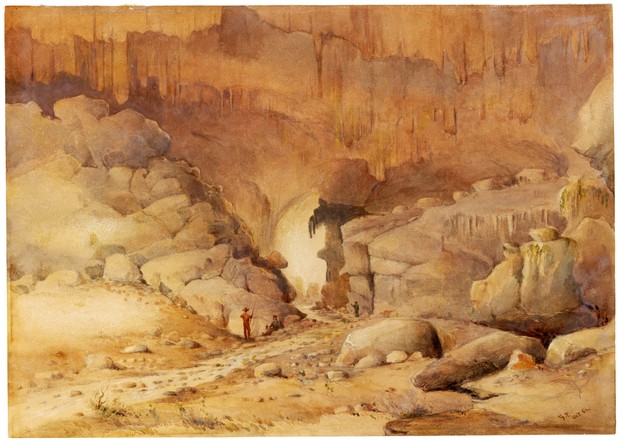The Entrance, Fish River Caves
October 1861
ML 1396
Watercolour
This painting is one of the first known images of the Grand Arch at the Jenolan Caves. In 1861, the caves were still relatively unexplored and were known by various names such as the Fish River Caves, the Bindo Caves or McKeown’s Caves. It wasn’t until 1884, when a parish map of the area was being prepared that they were officially named Jenolan Caves, after nearby Mount Jenolan.
This image was created by George Ferris Pickering’s in 1861, and depicts quite a different scene to what visitors see today. Pickering’s painting is of significance because it shows how the Grand Arch may have originally looked for thousands of years before tourism in the area boomed in 1880s. The influx of tourism had an immediate impact on the natural state of the caves. Parties of tourists making the trek to the caves camped in the Grand Arch or Devil’s Coachhouse, and would regularly snap off stalagmites or stalactites as souvenirs. By the mid 1880s as a result of the vandalism, many of the cave formations had to be protected by wire fences. A few years later when the main road into the resort was extended through the Grand Arch in 1896, pollution from the car exhaust blackened the formations.
The Fish River Stalactite Caves
‘The chain of rugged mountains which divides the metropolitan county from the more fertile districts westward, presents few objects of interest to the traveller to compensate for the tedious and uncomfortable journey across them. Almost the only relief from the monotony of a wretched road and stunted gum trees is in the romantic scenery which now and then opens out, stretching away as far as the eye can reach over billowy mountain ranges interspersed with huge crags and precipitous ravines, and occasionally with green cultivated patches One of the few attractions which the Blue Mountains possess-interesting alike to the scientific, and to sight-seekers generally consists in the curious subterranean excavations known as the Fish River Stalactite Caves. The beauty as well as the rareness of these formations entitle them to a description.…
The colours as well as the shapes of these formations attract great admiration. They are mostly white; some are slightly tinged with colouring matter showing the presence of iron; others, where the percolation has been purer, are perfectly white, and reflect the light upon innumerable crystals. Some of the larger and more compact masses have the appearance of wax, and bear a beautiful polish: this description, which is known as alabaster, has been extensively used for statuary.
All who have explored the Fish River Caves agree that they well recompense for the long and rough journey encountered in reaching them. The principal visitors have been from Bathurst, but occasionally picnic parties have been formed at Bowenfels and elsewhere on the Bathurst Road; the excursions generally lasting three or four days. The great distance of the caves, and the formidable road, have, however, prevented the visitors being very numerous.’
The Australian Home Companion and Band of Hope Journal 9 Feb. 1861 pp. 16-18



 Back to list
Back to list